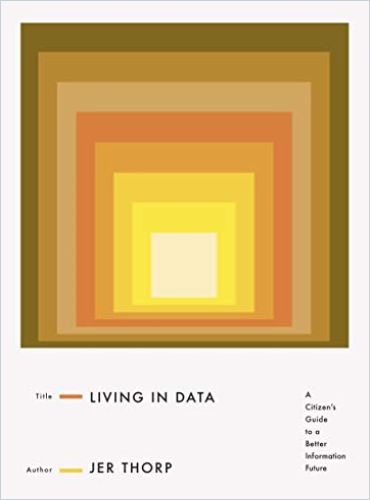Data visionary Jef Thorp takes you on a tour of data visualization, conceptualization, ownership and inequality, and inspires you to take control of your data.

Own Your Data
Data artist in residence at The New York Times and hugely popular TED speaker Jer Thorp’s passion is visualizing data to uncover its complex aspects and make the formerly invisible visible. To make data more equitable, he defends a decentralized web that would repatriate data’s many stories to the communities who created them.
Data Citizens
Starting in 2009, Thorp experimented on various data sources, including New York Times stories, the influenza genome, and timelines from Avengers comic books.
Closing the loop’ between data and the people from whom the data comes…is a critical theme of this book.Jer Thorp
People don’t find data – they construct data. To end inequality, people must acknowledge they are data citizens.
The Library of Missing Datasets
Those in power control data – who collects data, from whom and to what uses data can be put. This control reinforces social inequality. People must block collectors who invade their privacy, and take personal charge of their own data.
The group that has the data has no incentive to make it available, and the group that wants the data doesn’t have the resources to collect it.Data researcher Mimi Onuoha
Artist Mimi Onuoha, for example, accumulates datasets that don’t exist – such as datasets of people who can’t get into public housing due to criminal records, or how much Spotify pays artists for their songs. Scant coherent data exists, for example, on the number of civilians whom police kill. Marginalized groups such as ethnic minorities, Indigenous peoples, LGBTQ+ and the disabled suffer disproportionally from absent data.
To Thorp, data discovery often shrouds data’s often-darker purpose – to stake a claim on knowledge, and profit from it. Thorp seeks to further knowledge to protect it. Protecting those from whom you collect data requires their full participation and “when in doubt, don’t collect.”
Data, Metadata and Interdata
The “genesis moment” is the point at which data collection begins. From there, data break off and transform, fracturing into more and more data, about what the data are, where the data came from, what measurements were employed, and who analyzed the data.
You dream of one day throwing out the database and starting again with the one that will get it all right.Essayist Jacob Harris
Data collection is quantitative, and relies on a yes/no binary choice. But most people don’t live in a binary world. The mismatch between lived reality and “data reality” can cause problems when someone – or an algorithm – applies that data to real-world situations.
Large Numbers
Thorp seeks to depict enormous numbers that defy the human capacity to conceptualize. The human brain tends to generalize, putting in placeholders to stand in for millions, billions and trillions. This can dehumanize people into incomprehensible numbers.
At the entrance to the venue each person is given a grain of rice representing themselves.
Jer Thorp
Theater students at a university in Manchester, for example, sought to represent six billion people with “real, tangible objects.” Their instructor, James Yarker, chose rice grains as that object. Because the project would require 120 metric tons of rice to represent the world’s population, Yarker decided to show Britain’s population instead; he bought 3,000 kg of rice, or 60 million grains. He and his students realized this rice could represent almost any number of people, anywhere in the world.
Vulnerable People
“Public” data are open and available – but many marginalized communities lack easy access to such data. Silicon Valley has spent decades pushing internet users to commercial venues – rather than civic ones – because tech firms then profit from users accessing their own data.
The Map Room’s denizens can use personal narratives as a lens to read civic data, tracing a kid’s path to school through traffic or air quality data.Jer Thorp
In 2017, Thorp debuted The Map Room in a St. Louis school. There, students created maps of their neighborhoods that aligned with their lives, which they could compare to maps from historical records. The students’ maps, for example, reflected the redlining that began in the 1930s – and still persists today – to drive down Black property values and keep these mostly Black communities poor.
“Data Sovereignty”
Who owns data, if people house data all over the world? Google, Apple and Facebook store data in massive complexes in the United States, but the nations from which they collect the data have governance in those complexes.
To protect their rights and their heritage, New Zealand’s Māori, for example, claimed ownership of any data pertaining to land, property and artifacts that had Indigenous associations. The Te Mana Raraunga, an advocacy group for Māori rights, asserts that Māori data are subject to their rights as specified in the 1840 Treaty of Waitangi.
The Te Mana Raraunga created a database they based on the “whakapapa” – the ancestral origins, or the “ultimate catalog” – of Māori relationships between one another and their relationships to all things. Developers created a bottom-up demography that aligns with the Māori worldview. Anyone requesting access to Māori data must explain how he or she will use that data.
Givers and Takers
For 30 years, URLs have pointed to locations for data, but don’t care what you find when you click the link. Silicon Valley has made fortunes from building the “wheres” – holding user data captive, and charging users to access the data. Users are givers who seem unaware that they make takers very, very rich.
New ideas and new technologies are giving people ways to collect, store and share data outside corporate influence.Jer Thorp
To live in data, people must work together to dismantle the old, monopolistic models and replace them with communities, in which humans share their stories and feel like citizens, not mere subjects. By making data worlds more concrete and relatable, Thorp and others empower data citizens.
Art of Data
Jer Thorp, in addition to his community involvements worldwide, makes art from data so he and others can better understand and conceptualize it. He brings an artist’s dizzying ideas and insights to a subject few might ponder deeply. How dizzying you find Thorp’s approach may depend on your demographic; digital natives will easily digest and find inspiration in Thorp’s insistence on digital equity. Older readers may need time and possible multiple readings to grasp his more arcane concepts. However fast or slow your understanding, Thorp provides a seminal, revolutionary prism through which to view your data and to view the very idea of what constitutes your data.
Books addressing data include Weapons of Math Destruction by Cathy O’Neil; Big Data by Viktor Mayer-Schönberger and Kenneth Cukier; and Invisible Women by Caroline Criado Perez.






